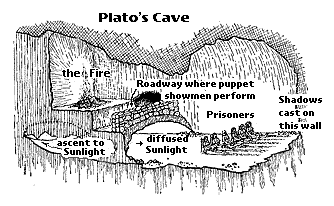
However, this is a necessary step towards obtaining true knowledge. At first, the light, obscuring the freed prisoner vision, puts him in an uncomfortable situation. Sunlight in Plato’s allegory represents wisdom, the higher truth of ideas. The freed prisoner represents those who understand that the physical world that we perceive around us is only a distorted projection of the truth.

To leave the cave means to seek true knowledge in Plato’s allegory. An illusion, a partial depiction of reality that the prisoners perceive in the cave. Thus, the shadows in the cave represent superficial truth. Therefore, these elements symbolize the false perceptions and the stereotype knowledge that we hold to be true. Shadows are distortions of images and echoes are sound distortions. The shadows and echoes are never an accurate depiction of the objects that cast them. They are trapped in ignorance and the chains are preventing them from learning the truth about the world around them. It is an allegory of the existential condition of the prisoners. A source of knowledge that, according to Plato, is erroneous and misleading. The chains represent the human body and senses. Such perception of reality does not necessarily hold the truth of a fact and is not necessarily grounded in science.

Practically, all of us who live in our limited perception of the world, are trapped in customary beliefs. The prisoners of the cave are ordinary men. This is the reason they believe that the shadows are true forms of the objects. Since the prisoners spent their entire lives in the dark cave, they never saw the actual objects that form the shadows. The cave and darkness in Plato’s allegory represent ignorance.

The ideas behind the allegory of the cave can be interpreted as follows: Cave and Darkness Plato infers that the other prisoners would think that leaving the cave caused blindness and would aggressively oppose any attempts to set them free. If he returns after exposure to sunlight, the dark will obscure his vision. A possible consequence of the first possibility would be the attacks he would suffer from his companions.
#Cave allegory explained free
The freed prisoner could do two things: return to the cave and free his companions or depart from the cave to live freely. He realizes that those shadows, which he believed to be reality, are actually imperfect copies of a small portion of reality. Then he begins to realize the infinity of the world and nature that exists outside the cave.

Gradually, his vision gets used to the light. Sunlight obscures his vision, and he feels helpless, uncomfortable, out of place. When he finds his way out of the cave, he is startled when faced with the outside world. Walking through the cave, he realizes that there were people and a fire casting the shadows that he believed to be reality. These shadows are the only knowledge that the prisoners have about the world. What the prisoners see and hear are shadows and echoes projected by these objects. The prisoners are unable to see the real objects behind them. The puppeteers, who are behind the prisoners, hold up puppets that cast shadows on the front wall. With their hands tied to a wall, they can see only the shadows that are projected on the wall.īehind the prisoners a fire burns, and there is a rampart, along which puppeteers can walk. In the text, Socrates tells Glaucon to imagine the existence of a cave where prisoners have lived since childhood. Plato’s Cave Relevance Today Allegory of the Cave.


 0 kommentar(er)
0 kommentar(er)
